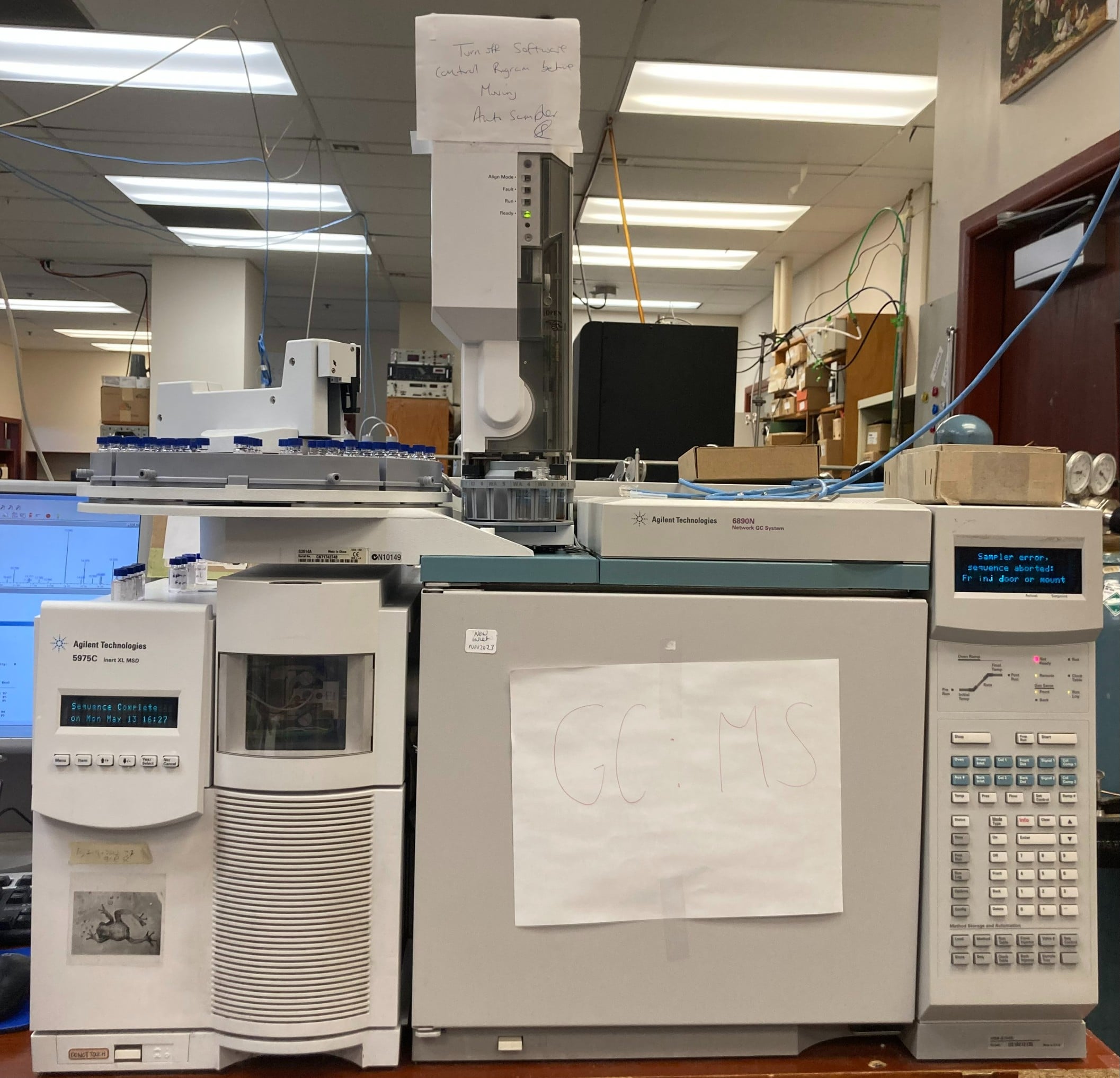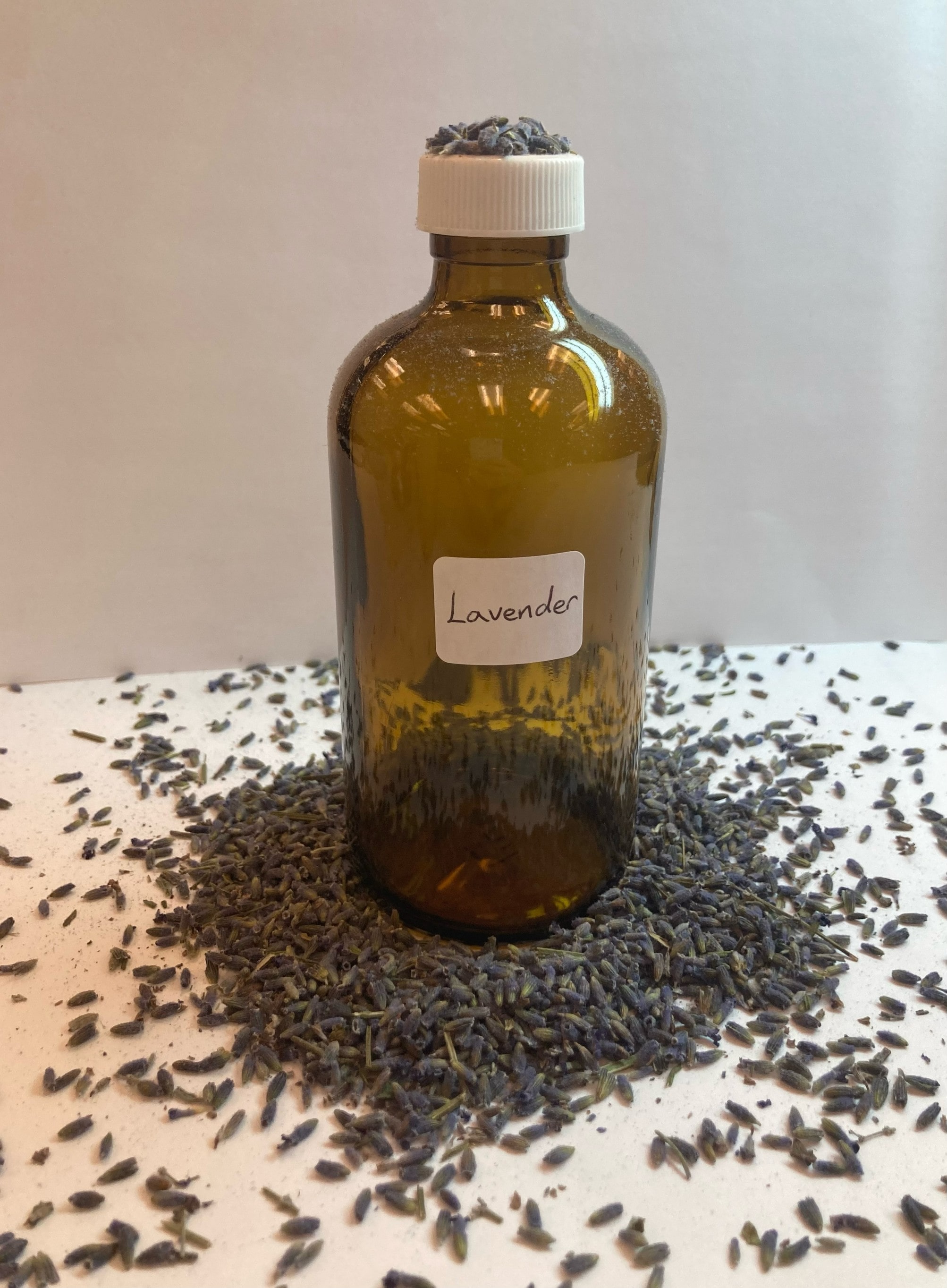
Lavender Hydrosol
Lavender oils and hydrosols contain more than 100 compounds with the two major constituents being linalool and linalyl acetate. Formed with terpenoids, lavender is a middle note that brings calming, floral and herbaceous aroma. With a scent that lasts longer than top notes, lavender is widely used in perfumery because of its versatility.
Hi, my name is Alexandra and I am a French undergraduate student in the second year of a bachelor degree in chemistry. I am specialized in analysis and would like to work in green chemistry.
I am doing my internship at the University of Ottawa and work on the chemical composition of hydrosols. I hope to learn more about the functioning of the GC-MS but also how it is used to analyse samples.
I had the opportunity to work on lavender and more precisely on the components of the different forms of lavender products : hydrosol, essential oil and fragrance oil.
This allowed me to compare the results of a microwave distillation with a hydro distillation. I was also charged of the analysis and comparison of the essential oil, complex mixture of volatile chemicals derived from the roots, leaves, flowers, and fruits of plants, with the fragrance oil which is a blended synthetic aroma compounds or natural essential oils that are diluted with a carrier.
Being a widely used plant, the documentation about lavender is necessary and I am more than grateful to be a part of it.

Analytical technique
Gaz Chromatography Mass Spectroscopy is an analytical method used to identify the volatile organic molecules that have a boiling point under 300 Celsius degrees. Helium, that is not detected by the device, is constantly in circulation and plays the role of a carrier gaz. The injection of 1 µL of sample is done to the septum level which vaporizes the sample and leads it into a spiral column. After that, the GC oven ramp heats the column making the components elute according to their boiling points and interactions with the column. Then, the mass spectrometer ionizes and fragments the molecules leading to their specific mass spectra equivalent to a fingerprint. Finally, the comparison of the obtained spectra with the data base allows us to identify the components of the sample. Several parameters such as the inlet temperature, the oven temperature and the ramp can be modified depending on the analyzed sample.
The GC-MS offers high sensitivity, specificity, and reproducibility in different analyses. It can detect molecules even at trace levels in complex matrices, making it a valuable tool for research and industry.

Distillation techniques
A hydrosol, also known as floral water, is the aromatic waters that contains the volatile water-soluble components of a plant. Obtained thanks to a distillation technique, it is used in beauty products, perfumery or even for their therapeutic values. It as a gentle aroma and contain small quantities of essential oils.
Distillation technique are based on the fact that increasing the temperature promotes the bursting of plant cells, which are then carried away by the steam.
The microwave distillation is a distillation technic allowing us to recover the hydrosol of plants without getting chlorophyll which are not enough volatile. With heat, steam goes up to the glass cone that condenses it, making it fall into the Becker. The glass cone is made with distilled water to control the ph. On the other hand, a mug with water is placed next to the jar in the microwave to prevent plants from burning. Three sessions of 7 minutes are made, the Becker’s contents are gathered, and the cone glass replaced.
Two microwave sessions were done using 100g of dry lavender plants and fresh lavender lowers in order to compare the chemical composition of those hydrosold by using the GC-MS analysis.

The hydro distillation enables the extraction of lavender essential oil from natural materials, the lavender flowers, through the principle of evaporation followed by vapor liquefaction. The condenser tube liquefies the vapors to obtain the distillate. This method yields a heterogeneous distillate: an aqueous part and an organic part are present.
The hydro distillation of lavender flowers was done with the following set-up. The ballon, containing 10g of fresh lavender flowers and 150mL of distilled water, was heated until 98°C during three hours in order to collect 40mL of hydrosol.

Lavender hydrosols by microwave distillation
For the dry lavender plants, the solid phase extraction was done tree times for different amounts of lavender hydrosol. This extraction allows us to remove the water contained in the sample in order to be able to analyse the volatile organic molecules. I needed to choose the right amount of hydrosol for the GC-MS analysis in order to operates my results but also to do the internal standard analysis. 1mL lavender hydrosol is not enough because some peaks are not detected by the chromatogram library search while 3mL lavender hydrosol is too much because the abundance of one component is higher than 1 600 000. Indeed, the analysis of 2 mL of lavender hydrosol is the best option because all the important peaks are detected without saturated the column.
In the case of the microwave distillation of recent lavender flowers, 1mL and 2mL were too significant requiering the use of 0.5mL of hydrosol.

The analysis of the dry lavender plants hydrosol was done three times to be able to compare the results.
As we can see, we have obtained linalool and more precisely (R)-linalool, a terpene alcohol found in many plants such as lavender and which provides a woody and lavender-like scent. Found in several plants, borneol and α-terpineol are organic compounds that contribute to the characteristic aroma while providing medicinal properties. The associate oxidant of borneol, camphor, has a strong aromatic odor and is a terpenoid that it used as an anti-inflammatory agent and decongestant. Benzenemethanol,α,α,4-trimethyl has a mild and pleasant scent and is used as a solvent in various industries, for example pharmaceuticals and cosmetics. Finally, 2-isopropenyl-5-methyl-4-hexenyl acetate is often found in fragrance and contributes to the overall scent and benefits. Several other compounds are present in the lavender hydrosol but in very less significant quantities.

An internal standard was then used to have a calibration curve allowing me to ascertain the concentration of each compound thanks to their area. For that, different amount of a solution with a concentration of 5µL/mL of 4-Ethylguaiacol was used as the intern and added during the solid phase separation. Not initially present in my hydrosol, the standard is then present in concentrations between 0.025 and 1 µL/mL. The analysis of the area of this product, which has a retention time around 9.5 minute, in each sample had allowed me to trace my calibration curve. After analysis of the results, the curve on the area of the standard as a function of concentration has a good R² of 0.995 which significate that the measurements were correctly conducting. However, an average of my results and the ones of the other interns were used so the equation is more accurate. I was able to calculate the concentration of my main compounds in my three hydrosol samples. Borneol is the most concentrated compound which is in line with the value of the % area obtained that is between 47 and 50% of the total hydrosol.

On the other hand, a hydrosol made from fresh lavender flowers by microwave distillation showed the presence of different chemicals such as linalool, camphor, eucalyptol, terpinen-4-ol and lavandulyl acetate. These results are logical because they are all organic compounds present in plants and particularly in lavender.
The chromatogram, representing the 10 main compounds, shows that other chemicals with higher boiling points are present in this hydrosol. α-caryophyllene, β-caryophyllene and caryophyllene oxide are natural sesquiterpenes that possess anticancer activities avoiding the proliferation of the cancer cells. Terpenes offer a wide variety of aromatic properties, with floral, earthy or citrus notes, but sesquiterpenes and particularly caryophyllene have a spicier side. Β-caryophyllene and caryophyllene oxide contain a cyclobutane ring, which is rare in nature and not found in any other known terpene. They are naturally found in lavender and especially in lavender flowers and are responsible for its anti-anxiety and inflammation-reducing properties.
The hydrosols obtained by microwave distillation have a light aromatic odor very similar to lavender with spicy and woody notes.

Lavender hydrosols by hydro distillation
A hydrosol from fresh lavender flowers was obtained through hydro distillation. This hydrosol contains 14 main chemicals including linalool, camphor, lavandulol, isoborneol, terpinene-4-ol, terpineol, linalyl acetate and lavandulyl acetate that were described previously. Eucalyptol, a natural organic compound, is commonly found in the hydrosol and essential oil of different plants such as lavender but its amount depends on the variety and species used. Indeed, the Lavandula latifolia contains a notable proportion while the Lavandula angustifolia is characterized by only small amounts. It is the case with my sample because less than 4% of Eucalyptol is present. My hydrosol contains both cis and trans linalool oxide which could be differentiated by standard analysis. Indeed, cis-linalool oxide has a lower retention time and retention indices. Consequently, my hydrosol is composed of more than 6% of cis-linalool oxide and around 5.30 to 5.40% of trans-linalool oxide. Those stereoisomers are naturally found in various essential oils including lavender and has unique aromas of flower and wood. Geraniol acetate possesses a pleasant floral are fruity rose aroma and is a terpenoid used in the fragrance and flavor industries. Finaly, nerol acetate, a monoterpenoid alcohol, has a fresh, floral, and citrus-like aroma.
This distillation technique led to a hydrosol with a slightly stronger lavender aroma.

Conclusion
To conclude, thanks to those analysis, I was able to compare the components of the lavender hydrosol, essential oil, and fragrance oil. It allowed me to define was compounds are common to all of them and which one were not. In the end, linalool is the only chemical that I have found into all my samples.

The results of the two-microwave distillation are very different. Only a few chemicals are common, and the proportions are very different. The lavender flowers hydrosol contains sesquiterpenes that are not visible in the dry lavender plant hydrosol. This major difference is linked to the used sample. During drying, the water content of lavender is significantly reduced, increasing the concentration of the remaining volatile compounds and thus intensifying the aroma. The main volatile components of lavender, such as linalyl acetate, may volatilize or transform during drying, which explains the absence of this compound in my hydrosol made from dried lavender. In this way, we can conclude that the part of the plant during the distillation would impact the final chemical composition. As we know, the leaves, flowers and roots of the same plants have not the same use.
However, the comparison of two distillation techniques with a common sample has shown that a lot more chemicals are shared. The main chemicals are linalool and linalyl acetate but also terpineol for the hydro distillation. It is normal that the results differs because a technique always impact the obtained results.
In conclusion, these analysis as shown that the change of sample has a bigger influence than the method and especially when a different part of the plant is use.
